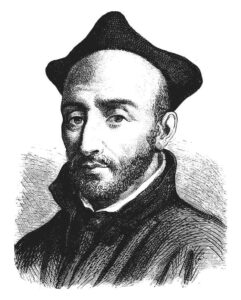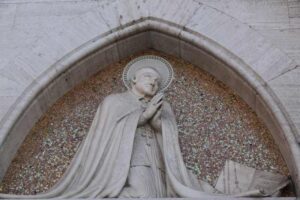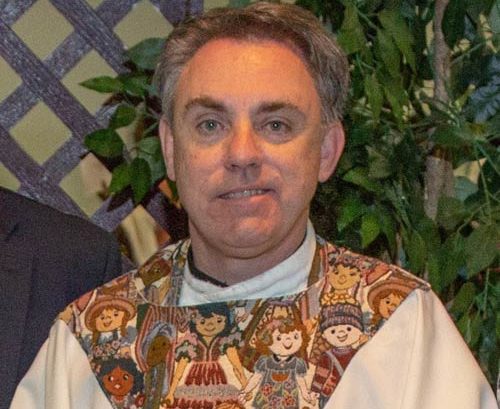JULY 31 ST. IGNATIUS OF LOYOLA DAY
AUG. 1 ST. ALPHONSUS LIGOURI DAY
We have two of the great religious community founders on consecutive days of the calendar, here in mid-Summer. One ends the July calendar; the other starts August.
Both saints started religious orders that left a great impact on Maryland, down the road. Both religious orders are still going to this day, from their start five and three centuries ago. They served more in the founding missionary efforts in our early America days of Maryland, with the Jesuits staying in many parishes up to the 1960’s in Southern Maryland, while the Baltimore diocese (no DC one until after WWII) getting diocesan priesthood coverage going for the rest of the state and into DC. The Redemptorists still run the Annapolis area parishes, while Jesuits mostly are still into their schools, but just have a few parishes in the Balt-Wash corridor. Now. Downtown Baltimore and Georgetown have the strongest Jesuit parochial presence, but there high school/college presence is abundant in the state and in DC.
Vocations to the Redemptorists are strong enough that my home parish in Bowie (founded in the 1960’s) has two priest vocations with CSRR’s. One of my former parishes also had a Redemptorist vocation recently. Of two former parishes of mine elsewhere, down in St. Mary’s there was a Jesuit vocation, as well as over in a Laurel parish, ordained while I served there. Yet their vocation numbers are dropping locally as we go along. Some other places in the world they are up.
In our Old Line State today, Jesuits have a presence in Baltimore and Washington and Faulkner, Maryland. Redemptorists have a presence in Annapolis today. Each started parishes in Maryland, with the Jesuits doing so dozens of times, with many schools begun, as well. The Jesuit corridor was begun more of Southern Maryland up to Washington and up to Baltimore. The Redemptorists were mostly of Annapolis, but also in a few DC places (past tense) and in Elkridge and Baltimore, with evangelism efforts in the early days of Forest Glen up to Frederick and up through Pennsylvania, along with the Baltimore area. over 100 times. The Redemptorists had the famed saint missionary John Neumann. Maybe the most famous early Jesuit saint in Maryland was John Carroll.
The Jesuits did most of the evangelization of Maryland. Ignatius founded their order and sent many on mission to this “new land” that had not the Gospel in it—but for the introduction of Christianity after the Columbus voyages.
The Redemptorists did a good part of evangelization, too, in our area. Alphonsus Ligouri founded them. It was a later period when that all began.
=========================================
Sunday, July 31st, Feast of St. Ignatius of Loyola

He was born in 1491, less than a year before Christopher Columbus discovered the “New World.” He was the founder of the Society of Jesus. The order puts SJ after the clergy’s name.
As a young man Ignatius loved to read about the exploits of El Cid, The Knights of Camelot, and the Song of Roland. When he was 17 years old, he joined the military and longed to be like the figures he read about in adventure stories. In 1521, During the Battle of Pamplona, Ignatius was seriously injured when his leg was shattered by cannonball. While recuperating in his Father’s castle, his sister-in-law gave him two passages to read about the life of Jesus. He would have preferred to read one of his adventure stories, but there were none to be had. As he reluctantly picked up those pages, he began to open his heart to the “encounter” God wanted him to have. As he began to read the life of Jesus and eventually the lives of the saints, his attitude began to change. As he continued to heal, he knew his military career was over, and he switched his earthly allegiance to a heavenly one as Our Savior became for him the King of kings. He eventually hung up his sword and his dagger at the Altar of our Blessed Mother at the Benedictine monastery of Santa Maria de Montserrat. As terrible as his wound was to his leg, as disappointing as it was to lose both his mobility and his career, it is amazing to think that those events ultimately led him to Christ. The time spent in recuperation from his battle wounds in the end, led him to the greatest adventure of his life.
If one reads the story of today’s saint, then you might be moved to a new view of things for today’s situations. Back then and today, God does not find much availability and openness among the comfortable; He gets more avenues of grace to us via the restless times. While God does not bring us suffering or pain or ways into sin, He does work in the realm of this brokenness to point out the Light of His Way. It’s Ignatius story. Over the last couple of years or more, many have been forced to isolate or change their lifestyle into one of caution. The covid-19 threat (and its variants) has been real; many have become ill with it. Some have had to recuperate over a slow and painful period of time. Some still have its effects in them, in the coined “slow covid.” In a phrase, life has been altered for many since the pandemic. It may never return to the same as before.
Although life has been altered and the list of disappointments keeps growing, we might share the hope of the Prophet Jeremiah, who is being read in daily Mass in these days, that in the midst of the pain, something is happening in the realm of faith. God is offering opportunities amid the struggle. Our new saints are being formed and Christ’s Church is being built up. May it be so! St Ignatius of Loyola, pray for us! Praised be Jesus Christ now and forever! Amen.
Monday, August 1st Feast of St. Alphonsus Ligouri.

Alphonsus Ligouri was an Italian man, born in 1696.(That’s about two centuries after Ignatius of Loyola of Italy.) He grew up as a brilliant Catholic student, and at the University of Naples, Alphonsus received a doctorate in both canon and civil law by acclamation, at the age of 16, but he soon gave up the practice of law for apostolic activity. He had done much thinking and reasoning already about moral virtue and the life lived for what’s good and just, according to the call of Christ. He would follow that path for his whole life. He was ordained a priest, and concentrated his pastoral efforts on popular parish missions, hearing confessions, and forming Christian groups. He excelled in the category of explaining moral theology, showing how our actions need to be in pursuit of virtue and Christ-likedness. He said the moral life is nourished by Scripture, and that the nobility of the Christian vocation of the faithful is how the go forth in love and truth to love people in the world and invite them to Jesus.
In his day, Alphonsus fought for the liberation of moral theology from the rigidity of what was called Jansenism. His moral theology, which went through 60 editions in the century following him, concentrated on the practical and concrete problems of pastors and confessors. If a certain legalism and minimalism crept into moral theology, it should not be attributed to this model of moderation and gentleness. He won many followers of his religious order, who went out to the world.
Redemptorists are known today for their missions. They help to revive parishes and peoples. They work against the tide of popular culture, seeing so many people caught in so many ways of sin that would be secular humanism or agnosticism. The Redemptorist can relate to the prophet Jeremiah, of whom the Church Lectionary now features in Summer readings. Jeremiah met much opposition to his message. As it says in The Word today: When Jeremiah finished speaking all that the LORD had bade him speak , the priests and prophets laid hold of him, crying, “You must be put to death!” The priests and prophets said to the princes and to all the people, “This man deserves death; he has prophesied against this city, as you have heard with your own ears.”
If you are thinking this Scripture section about Jeremiah also does sound a lot like the accusations made against Jesus, you would be right. There is a reason this same Book of Jeremiah is read with such frequency during Holy Week. Jeremiah is the “suffering servant” who is unjustly condemned.
Yet I love the confidence of Jeremiah, as I love a determined Redemptorist priest. I love how they are determined to please the Lord, not man—the just person is to be obedient to God’s Word. Jeremiah declares, “As for me, I am in your hands; do with me what you think good and right.” Jeremiah is persecuted, yet he is spared in the end by God.
FINALLY….
It is remarkable how closely those words of the prophet Jeremiah will resemble the words of St. Paul in his Letter to the Romans, who wrote: “If we live, we live to the Lord, and if we die, we die to the Lord; so then, whether we live or whether we die, we are the Lord’s.” This pretty much sums up the life of a saint, does it not?
Both of Friday’s and Saturday’s saints were soldiers of God’s virtue and labored for the souls of their neighbor to come to God’s truth and be converted.

